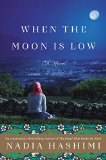Book Club Discussion Questions
In a book club? Subscribe to our Book Club Newsletter!
For supplemental discussion material see our Beyond the Book article, Afghan Women's Writing Project and our BookBrowse Review of When the Moon Is Low.
Please be aware that this discussion guide will contain spoilers!
Introduction
The unforgettable story of an Afghan family's escape from the Taliban and perilous trek across Europe to seek asylum, led by one extraordinarily courageous woman. This is the second novel by Nadia Hashimi, the author of 2014's breakout novel,
The Pearl That Broke Its Shell.
Questions for Discussion
- Fereiba describes herself as "an outsider in my father's home" as a child, and then becomes a literal outsider as a refugee. What do you think the author is trying to say about being an outsider? Is there anything positive to be gained from having an outsider's perspective and experience? Who are the outsiders in your family or society?
- What do you make of KokoGul? Is she the classic "wicked stepmother", or are there more layers to her? What do you think she was like at Fereiba's age? What motivates her most as a wife and mother?
- In hindsight, knowing what happened, did Fereiba make the right decision to leave Kabul? Was she right to press on towards London without Saleem? What would you have done in her situation?
- Fereiba's family frequently gets by thanks to the kindness of strangers, particularly Hakan and Hayal, the Turkish couple who take in the family and generously help support them. Why do you think Hakan and Hayal do this? Should Fereiba's family have stayed in Turkey with them? What compels them to leave a seeming safe harbor and continue to Europe?
- When Saleem is talking with Roksana about why she works to help refugees he "wondered what kind of person he would be if he were in her shoes. Would he take up the cause of strangers? Would he care enough about how people were being treated that he would spend his time handing out food and filling out applications on their behalf? He hoped he would. But it was very possible he wouldn't." Would you?
- Saleem's journey is dramatically affected by three girls his own age: Ekin, the Turkish farmer's daughter, Roksana, the Greek aid worker, and Mimi, the Albanian prostitute. What does he owe to each of them? Why do you think they helped him, even when it was risky for them?
- Who is the man Saleem encounters in the refugee camp in Calais? Is he really, as he claims, a friend of Fereiba's beloved grandfather?
- There is water imagery throughout the novel. As the old man stares out over the English Channel that divides Saleem from his family, we read that "From here is was easy to see the currents, linear streams of water a shade different from the rest of the ocean, like secret passages within the depths." As Saleem gets closer, Fereiba dreams of him "swimming across a brilliant, blue ocean...There was water all around him, and he glided through, swimming in smooth, strong strkes as if he'd been raised by the ocean." What is the significance of the water imagery? What message does it carry about the family's journey?
- What do you think happens to Saleem? Is he ultimately reunited with his family? What will happen to Samira and Aziz? How will their lives be different than their older brother's?
Unless otherwise stated, this discussion guide is reprinted with the permission of William Morrow Paperbacks.
Any page references refer to a USA edition of the book, usually the trade paperback version, and may vary in other editions.
For supplemental discussion material see our Beyond the Book article, Afghan Women's Writing Project and our BookBrowse Review of When the Moon Is Low.
